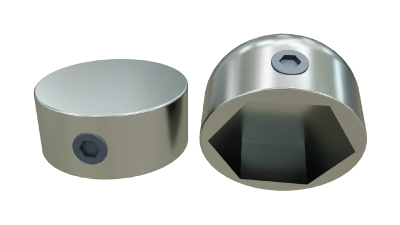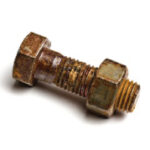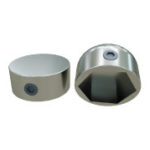Nut Guard
For use on any rotating equipment, outdoor equipment, or security equipment where theft, vandalism, or damage is of concern.


Ready to License or Manufacture
The engineering and patent work is complete!
Nut Guard is ready for licensing or manufacturing today.

Watch!
See Nut Guard in action. This 3D animated video will provide a detailed look at the features and benefits of this invention.
Purpose
The invention was developed for use on any rotating equipment, outdoor equipment, or security equipment where theft, vandalism, or damage is of concern. A user will first select the correct size for the nut or bolt head they are securing, while making sure the nut or bolt has been thoroughly tightened. They’ll then mount the Nut Guard on the nut or bolt and secure it with the set screw for protection. When the time comes to remove the fastener, the Nut Guard is simply removed without damage.

The Problem
Bolts and nuts are among the most common type of mechanical fastener in use today.
However, they are easily damaged, leading to failure.

The Solution
… But now, there’s the Nut Guard!
Contact Us
Contact us NOW to learn about manufacturing, retail, wholesale, distribution, or licensing opportunities for Nut Guard.
For Use on Nuts and Bolts
Ensures Fasteners Remain in Place
Protects Fasteners from Damage or Unauthorized Removal
Guarantees Failure of a Single Nut or Bolt Head Will Not Result in Catastrophic Failure
Can Be Removed After Use Without Damage
Story Behind the Invention
Inventor Fred A. Fernandez of Cedartown, GA has created a protective cover for a nut or bolt head. The invention was developed for use on any rotating equipment, outdoor equipment, or security equipment where theft, vandalism, or damage is of concern.
With a small farm of approximately thirty acres, Fred and his wife were bush hogging about fifteen acres and mowing around six. Over a period of years, the bolts on the mower deck would get rounded off or get knocked off completely from hitting things like rocks, stones, and small stumps. When trying to replace or sharpen the blades, a standard wrench or socket wrench would not work. They ended up using a pipe wrench or just cutting the bolt head off and trying to unscrew the part of the bolt still in the socket.
This all meant having to spend a lot of time and money to do the job. Plus, there was the inconvenience of having to buy replacement bolts, washers, and even gears. The stump jumper on their bush hog even fell off because of striking objects, which broke off the cotter pin, loosened the nut, and caused the stump jumper and blades to drop off and lose the castle nut. Fred just knew there had to be a better way. In turn, he began devising the Nut Guard.
When buying a spare tire for his trailer, which he mounted on the side of the trailer, the salesman at the tire shop suggested that he purchase a lock so nobody would be tempted to steal it. After procuring a lock, Fred realized that the mounting bolts could be unscrewed, and the tire could still be removed. He then realized the Nut Guard could be used to secure mounting bolts, too. From there, he thought about the lug nuts on the tires and how cutting a groove in the head of the bolt would allow it to turn without unscrewing the bolt, even with a pipe wrench, which would provide added security. With these things in mind, the Nut Guard was created.
But how does it work? A user will first select the correct size for the nut or bolt head they are securing, while making sure the nut or bolt has been thoroughly tightened. They will then mount the invention on the nut or bolt and secure it with the set screw for protection. When the time comes to remove the fastener, the invention is simply removed without damage.

